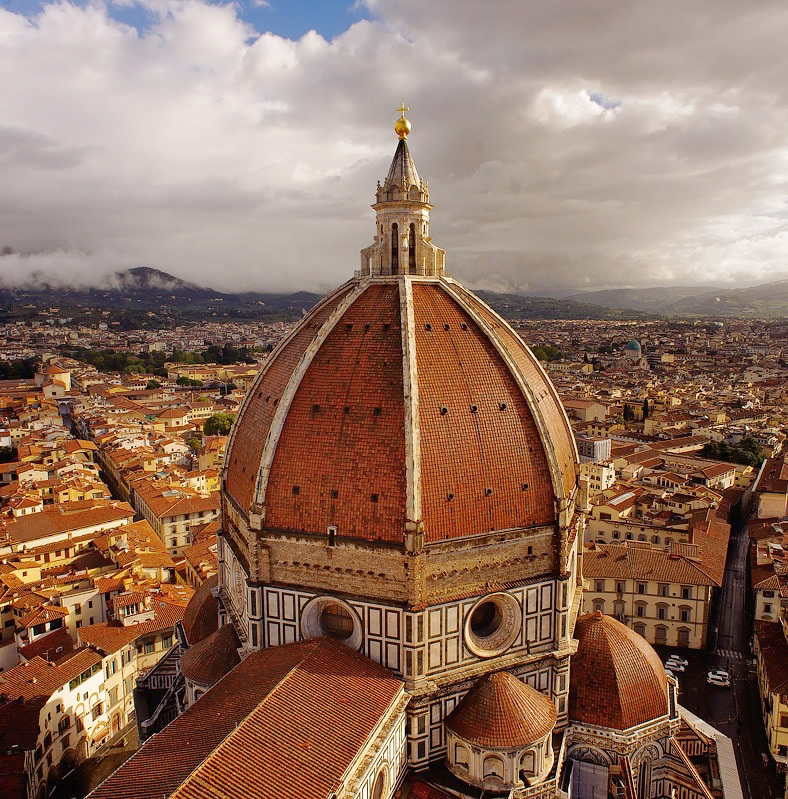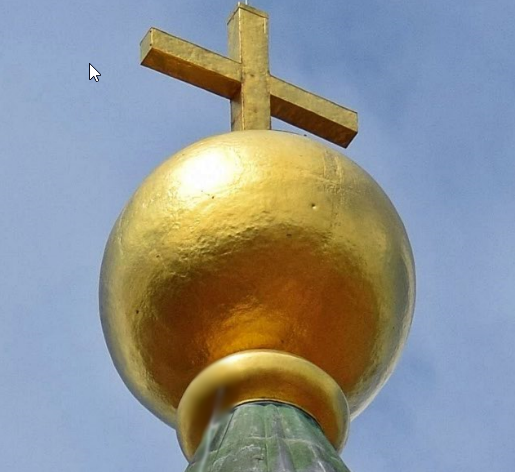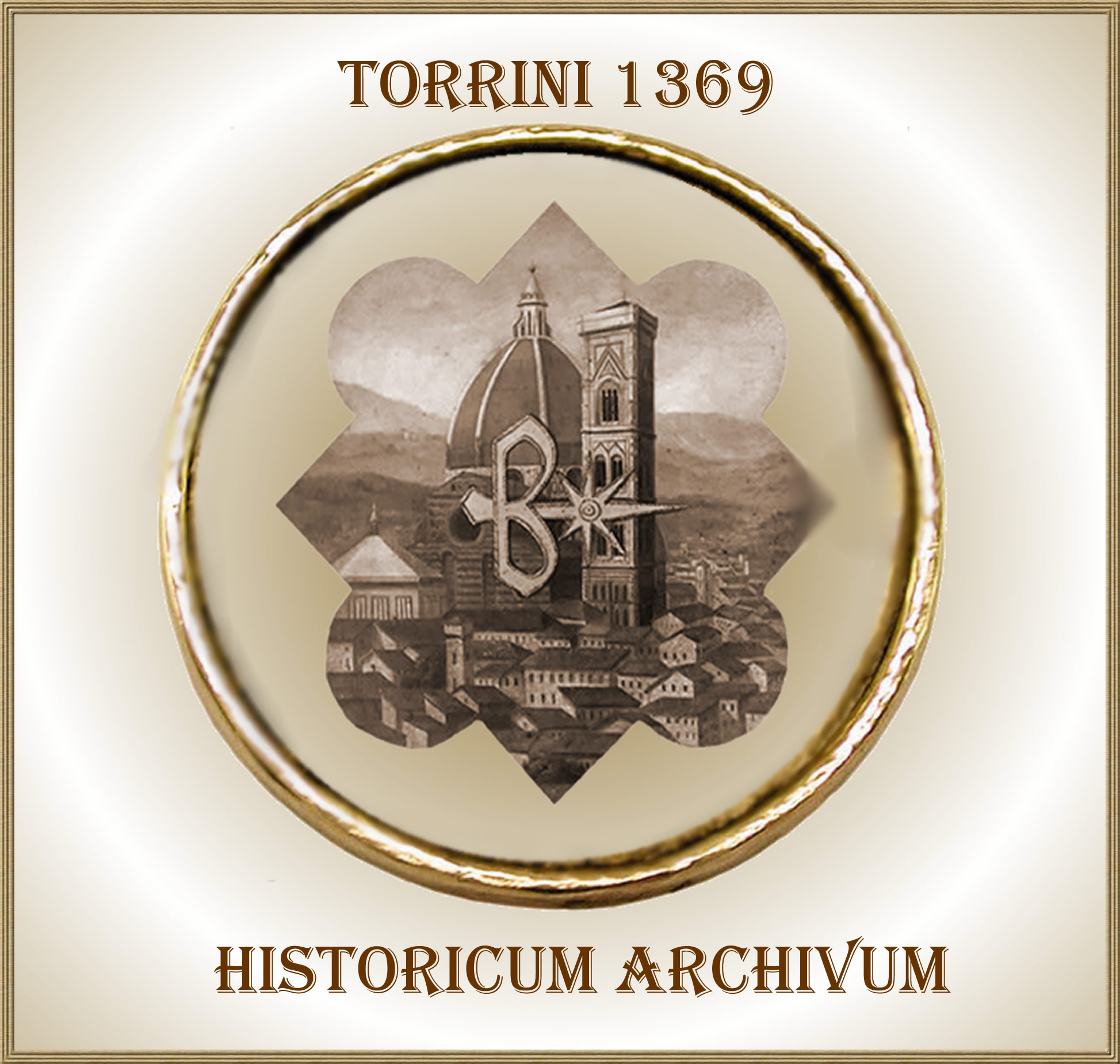- Home
- FLORENTINE STORIES
- The Dome of the Florence Cathedral.
The Dome of the Florence Cathedral.
(which the Florentines call "I’ Cupolone")
(from Florentine Stories by Franco Torrini)
 We are in 2020 and therefore on 7th August six hundred years have passed since the start of the works on the Dome by Ser Filippo Brunelleschi. An architectural work studied, turned upside down in a thousand ways, a myth of young and old engineers, extremely solid and beautiful, even today, although it is partly understood, it retains its legendary charm that comes from many small aspects and details discovered but also not fully understood.
We are in 2020 and therefore on 7th August six hundred years have passed since the start of the works on the Dome by Ser Filippo Brunelleschi. An architectural work studied, turned upside down in a thousand ways, a myth of young and old engineers, extremely solid and beautiful, even today, although it is partly understood, it retains its legendary charm that comes from many small aspects and details discovered but also not fully understood.
We were in 1420 and how exactly Brunelleschi did a few years earlier to think of such a construction, based on concepts then unimaginable, then erected with an empirical technology that is unmatched by any other example in the world, can only be the result of a personality certainly brilliant but just as close to pure madness.
Il Brunelleschi to arrive at the 95 meters of the apex of the Dome during construction (the Lantern measures 21 meters and therefore the total height is 116.50 meters),
it is said, he used curious devices such as the sort of walkway almost a kilometer long that started from Via della Scala in Santa Maria Novella to gradually bring his master masons with their unskilled workers, together with winches, tie rods and pulleys, up there on the Dome that grew with their brisk work, day by day, a few centimeters.
Ser Filippo loved to do the most important things on his own and his visits to the kilns of Impruneta for the supply of the basic bricks, tiles that he used to mark with his own signum, made him aware of the existence of a dish typical of the area called Peposo. A poor dish for poor people but extremely energetic and therefore suitable for giving strength and vigor to the workers who were "up there in the air" all day, winter and summer. In order not to waste time, he had the large pots of peposo brought up with the winches turned by oxen so that every day at 12 the workers could, at the sound of the bell, eat well without having to go ashore. A decision, his, which aroused some complaints that today we could define trade union but which he himself managed to quell.
The vicissitudes of the great work speak of the great rivalry that arose with the assignment given by the Opera of S. Maria del Fiore in common to Brunelleschi and Ghiberti and the subsequent abandonment of the latter after 5 years, who having finished his work of pure goldsmith model maker, he surrendered to the strong but quarrelsome personality of Brunelleschi.
Removed the laces with the departure of Ghiberti in 1425 (see Ghiberti's letter to Giovanni Turini at the Torrini 1369 historical archive) Ser Filippo completes the great, immense building work in nine years that will be inaugurated by Pope Eugene IV on 25 March 1436, the first day of the Florentine calendar year.
It is not possible to reconstruct the overall cost of the Dome even if we have many indications of small expenses and the certainty that there were about 300 between master masons and unskilled workers who worked every day from 8 to 14 hours depending on the season.
A series of loans that came from the Opera di Santa Maria del Fiore operating since 1296 as superintendent of the construction of the Cathedral and supported by the Florentine Republic and the gabelles applied by it to the transit of things and people. There were also great financial support from the Medici family and the Florentine people through, for example, the unique so-called "moccoli" gabelle. In Florence the blasphemies were called by the people "moccoli" and this bad habit was sanctioned with a very ........... flourishing gabelle!
This is why the Florentines said that the dome of St. Peter's in Rome was supported by the Pope and that of Florence by "moccoli"!
It is also said that Michelangelo leaving Florence for Rome, referring to Brunelleschi's Dome, wrote to his father the now legendary phrase: "I'm going to Rome to build your sister, bigger than you yes, but not more beautiful".
 Some curiosities matured over the centuries tell us about the sphere placed at the top of the lantern with its beautiful cross. It was Leonardo's master, Andrea del Verrocchio, still a goldsmith, who built it between 1468 and 1471. A very dangerous work with its 20 tons of copper, covered with a thin leaf of pure gold. Beyond its beauty, an exceptional bait for lightning during the many storms including those of 1492 when they seriously damaged the golden ball and those of 1600 that threw it from its pedestal and made it fall to the ground. Precisely where even today you can see a commemorative plaque right in front of the Palazzo de 'Bischeri in Piazza Duomo.
Some curiosities matured over the centuries tell us about the sphere placed at the top of the lantern with its beautiful cross. It was Leonardo's master, Andrea del Verrocchio, still a goldsmith, who built it between 1468 and 1471. A very dangerous work with its 20 tons of copper, covered with a thin leaf of pure gold. Beyond its beauty, an exceptional bait for lightning during the many storms including those of 1492 when they seriously damaged the golden ball and those of 1600 that threw it from its pedestal and made it fall to the ground. Precisely where even today you can see a commemorative plaque right in front of the Palazzo de 'Bischeri in Piazza Duomo.
Grand Duke Ferdinand II was prompt to restart the immediate reconstruction and in 1602, on 21 October, the "ball", a little larger than the original, was relocated to the apex of the lantern. On the advice of Buontalenti, a manhole opening was made in the upper part in order to carry out the necessary maintenance works. Relics were placed inside the cross due to the superstition of the Florentines and since at that time the only defense was to appeal to the Saints!
After six hundred years this great work is still there with its primates and its secrets.
My story stems solely from the desire to emphasize how Brunelleschi, Ser Filippo popularly known as Pippo, acquired knowledge by being an apprentice in the workshop of a goldsmith, Benincasa Lotti, where his father, Notary, had kindly posted him. Already as a young goldsmith he applied himself to mechanical conjectures by working on clocks (he also made a destock, something like an alarm clock), thus highlighting his natural talent for engineering that led him in the following years to study the architecture of ancient Rome to then transfer them to his main work permeated with mathematical knowledge, geometry and as a fine lover of perspective and sculpture.
In doing so, I want to highlight how important it was then to do an apprenticeship in a goldsmith's workshop to learn the sense of proportions and the basic design for each work of art then, both of them, put into contact with manual skills, took definitive body with the original thought.



